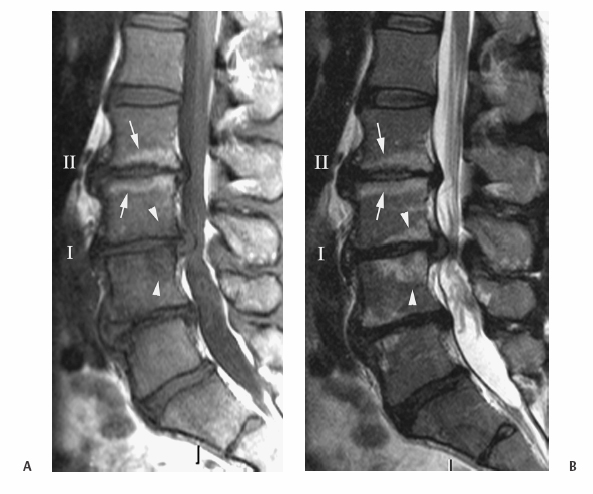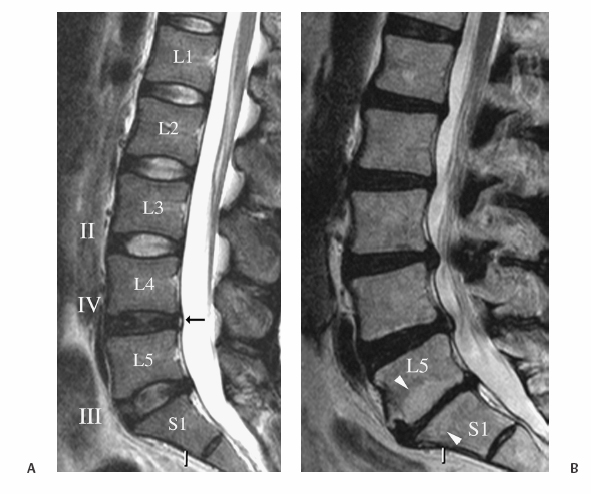14 Degenerative Disc Imaging Troy Hutchins and M. Marcel Maya Essential to radiographic evaluation of lumbar degenerative disc disease are appropriate patient selection and thorough clinical evaluation. A significant overlap of radiographic findings between symptomatic and asymptomatic individuals can lead to misdiagnosis or mistreatment. One study of 98 asymptomatic patients showed 64% of patients had at least one disc abnormality on lumbar spine magnetic resonance imaging (MRI),1 findings supported by numerous additional studies.24 It is therefore crucial to carefully interpret imaging findings with respect to specific clinical signs and symptoms. In this chapter we review the current concepts in degenerative disc imaging, focusing on the findings that are most important in affecting patient outcome or clinical research. Plain films have a low sensitivity for detecting early degenerative disc disease (DDD). Late findings of disc space narrowing, sclerotic endplate changes, and gas centrally within the disc (vacuum clefts) are common in the elderly and correlate poorly to symptoms.5 Although computed tomography (CT) provides better bony detail and soft tissue contrast than plain films, MRI is best suited for the evaluation of disc morphology and content, as well as marrow changes in the adjacent vertebral endplates, and will be the focus of discussion. Provocative testing (discography) is covered in Chapter 15. Typical MRI protocols consist of sagittal T1-, T2-, and axial T2-weighted images. Contrast-enhanced images are usually reserved for patients with previous disc surgery6 or suspected infection.7 Sagittal T2-weighted MRI is best for demonstrating degenerative changes of the disc, thought to be secondary to loss of proteoglycan and fluid content. Pfirrmann et al8 developed a five-level grading system for disc degeneration to standardize disc assessment for research and clinical applications.9 A normal adolescent disc (grade I) has white signal equal to that of cerebral spinal fluid, a homogeneous contour, no loss of height, and clear distinction between the anulus fibrosus (AF) and nucleus pulposus (NP). A normal adult disc (grade II) shows similar features but has an inhomogeneous contour and may have horizontal gray bands. A mildly degenerated disc (grade III) will be gray in signal with indistinct AF-NP border and may have normal to slight loss of height. A moderately degenerated disc (grade IV) will show complete loss of AF-NP distinction, will be gray or black, and may have normal to moderate loss of height. A severely degenerated disc (grade V) will be black with a collapsed disc space (Table 14.1; Fig. 14.1 ).8 The importance of such a standardized grading system is illustrated by a study that evaluated risk factors for recurrent disc herniation after microdiscectomy. Lower-grade discs showed higher rates of recurrence, with a 6.8-fold increased risk in grade II (normal adult) versus grade IV (moderately degenerated) discs, a finding with meaningful implications in preoperative patient counseling.10 Fig. 14.1 T2-weighted magnetic resonance images. (A) Grade II discs (normal adult) are noted from L1-L2 to L3-L4, grade IV (moderate degeneration) at L4-L5, and grade III (mild degeneration) at L5-S1. Note differences in nucleus pulposus/anulus fibrosus distinction from distinct (grade II) to indistinct (grade III) to absent (grade IV). An annular fissure high-intensity zone is noted at L4-L5 (arrow). (B) Grade V disc (severe degeneration) is noted at L5-S1, with associated endplate changes (arrowheads). T1-weighted imagess are needed to determine if they are Modic type I (low T1-weighted) or II (high T1-weighted). Since their first description by Modic et al in 1988,11 our understanding of the three types of vertebral endplate and marrow changes associated with degenerated discs in the lumbar spine and how they relate to segmental instability and low back pain has evolved. Modic type I changes represent vertebral endplate fissuring with infiltrative vascularized fibrous tissue, reflected on MRI as an edema pattern of decreased T1- and increased T2-weighted signal. Type II changes represent postischemic yellow marrow infiltration, with MRI findings of increased T1-weighted, and normal to increased T2-weighted signal reflecting fatty content. Type III changes are those of sclerotic, woven bone, demonstrated by T1- and T2-weighted hypointensity (Fig. 14.2).11,12 Modic type I changes are the most important to recognize on imaging, as they may best correlate to segmental instability, discogenic low back pain, and positive response to lumbar fusion.12–18 Their MRI signal characteristics are easy to remember as those of inflammation or edema found in other parts of the body (low T1-, high T2-weighted). Type II changes are generally believed to represent the evolution of type I changes to a more stable state: less associated with pain and less responsive to surgical fusion.13,19 However, some recent studies have questioned this concept, suggesting that type II changes can reconvert to or develop superimposed type I changes.13,20 To date, little is known of the clinical significance of type III changes (Table 14.2).13 Modic changes can be further classified as mild (<25% vertebral body height), moderate (25 to 50%), or severe (>50%), using the vertebral body most severely affected. A correlation between severity of endplate changes (types I and II) with concordant pain on discography has been suggested although not conclusively proven.12 Disc infection with adjacent vertebral body osteomyelitis (spondylodiscitis) needs to be differentiated from Modic type I changes, as both create a marrow edema pattern on MRI (T1-weighted hypointense, T2-weighted hyperintense, T1-weighted post-contrast enhancement).7,21 The combination of high T2-weighted disc signal, vertebral endplate irregularity, and epidural or paraspinous inflammation should lead to a diagnosis of spondylodiscitis.7,21 High T2-weighted signal in the disc alone should be interpreted with caution, as degenerated discs with vacuum clefts can accumulate T2-weighted hyperintense fluid after prolonged supine positioning.22 In questionable cases, C-reactive protein is a sensitive marker for infection and is nearly always elevated in spondylodiscitis.23
Imaging Findings
Disc Morphology

Vertebral Endplate/Marrow Changes (Modic)
Disk Infection

Stay updated, free articles. Join our Telegram channel

Full access? Get Clinical Tree









